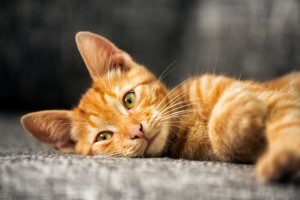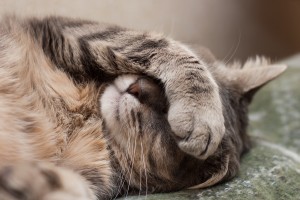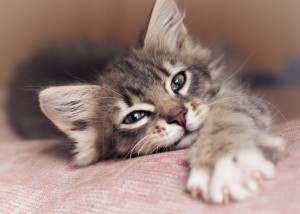 By François G. Cellier
By François G. Cellier
March 5 2016 — The Obsessive Compulsive Disorder (OCD) is not reserved only to humans. Cats can also be afflicted for various reasons. Behaviors often associated with this disease include biting objects, chewing cables and electrical wires, to name a few.
It might also be a question of alopecia, meaning that the animal licks itself to excess and to the point where it loses its hair and is left with a sparse coat.
Turning Around
Stereotyping is another symptom associated with OCD in a cat. It results in a continuous back-and-forth movement from point A to point B. Stereotyping is also shown when the cat turns around in circles, like a caged tiger in a zoo.
OCD can be genetic, but also caused by surrounding “hypo stimulants,” improperly enriched to meet the needs of a cat. “In short, often felines become OCD when they are bored stiff in their environment,” says Daniel Filion, feline behavior consultant and owner of Éduchateur. Therefore, they choose so-called compensatory activities.
Cats are led by motor patterns which fuel their natural instincts, such as running, hunting and jumping. The problem is that often these motor patterns cannot all be satisfied. « For example, if the cat needs hunting 10 minutes a day, and its owner does not play enough with it to maintain this innate need, a cat will fill this gap by drawing on other motor patterns like chewing electrical wires and other soft materials.
Remedies
Unless the OCD requires the care of a veterinarian, the solution to this problem is to enrich the environment of the cat. There are many ways to achieve this and they must be adapted to the needs of the animal concerned. We can among other things use interactive bowls like Stimulo. They force a cat to make more effort to take out the food. “The 15 to 20 minutes during which it invests daily, help reduce some needs in compensatory activities,” summarizes Daniel Filion.
When a cat is subject to a major change in lifestyle habits, such as the divorce of its owners, OCD may still appear because of tremendous stress that the animal may suffer. In this specific situation, the remedy may lie in a redevelopment of its environment, for example by including cat trees and shelves screwed to the walls so that it may climb.
Boredom
In addition, many cats develop OCD when they are left alone all day. With the return of everyone in the evening, the animal turns into a real dynamite, giving the impression that he is hyperactive, whereas this is not the case. Again, it is necessary to enrich its living environments to compensate for the absence of occupants, for example by playing more often with it back home after work.
 In conclusion, it must be remembered that preventing the manifestation of OCD may only be futile. Rather, you must ensure that the animal no longer feels the need to express the symptoms and when needed, you should redirect its behavior. This will give much more meaningful results.
In conclusion, it must be remembered that preventing the manifestation of OCD may only be futile. Rather, you must ensure that the animal no longer feels the need to express the symptoms and when needed, you should redirect its behavior. This will give much more meaningful results.
Warning: If your cat regularly ingests inedible material (e.g. Wool and polar), it probably developed a condition called Pica. In such circumstances, Daniel Filion recommends that you contact Dr. Isabelle Demontigny-Bédard, a specialist in this matter at the DMV Veterinary Center and the Veterinary Hospital and Sherwood Park.
Like this article? Like us on Facebook.
All rights reserved
Photo1: Dollar Photo Club/Igor Mojzes
Photo 2: Dollar Photo Club/Sergey Khamidulin
Photo 2: Dollar Photo Club/Katyamaximenko
You may also watch ou videos that are subtitled in English.
Click on the icon on the right hand side:
Balinese Cats/Zootherapy and autism/Advertising Video of Realité Animale


